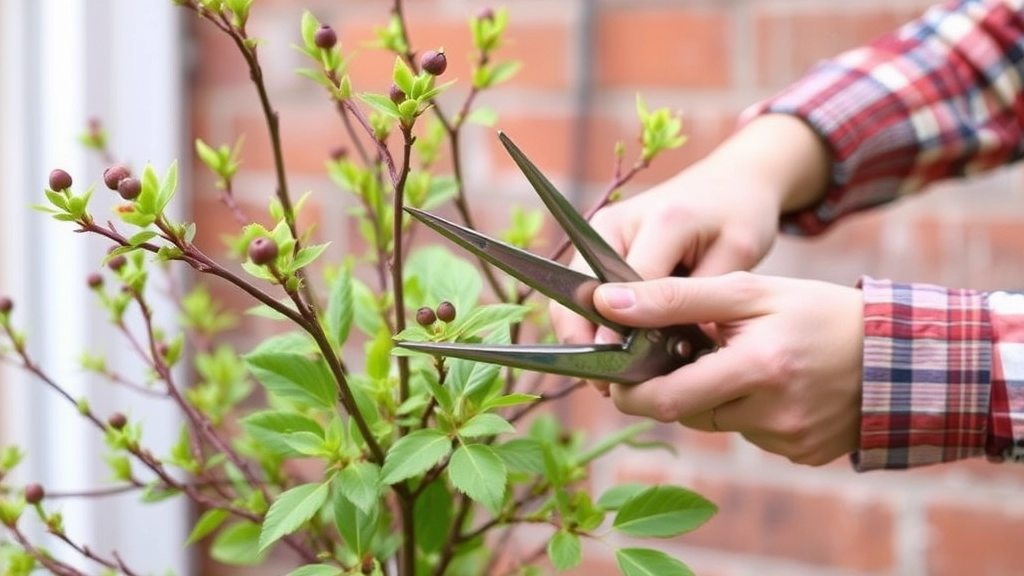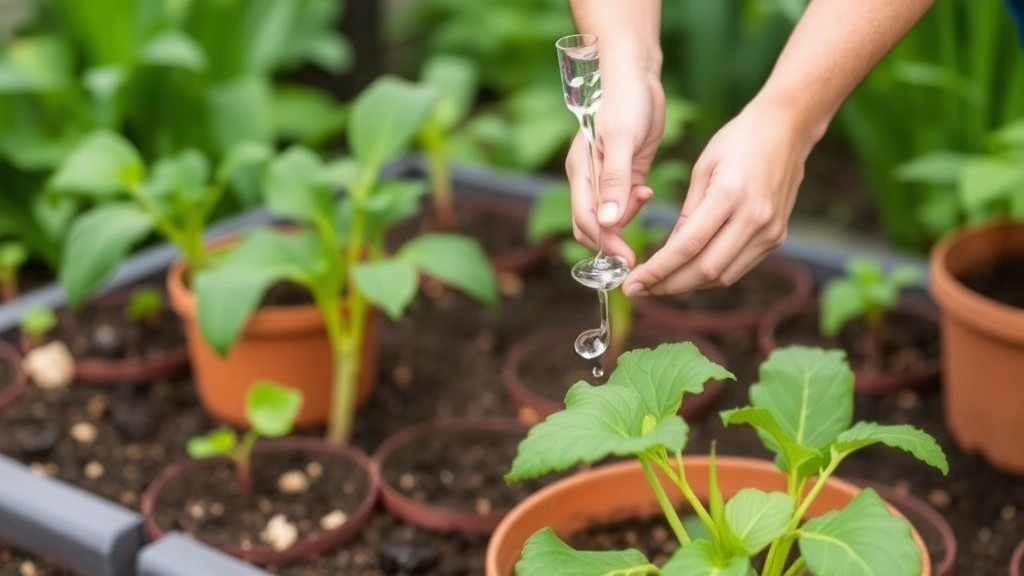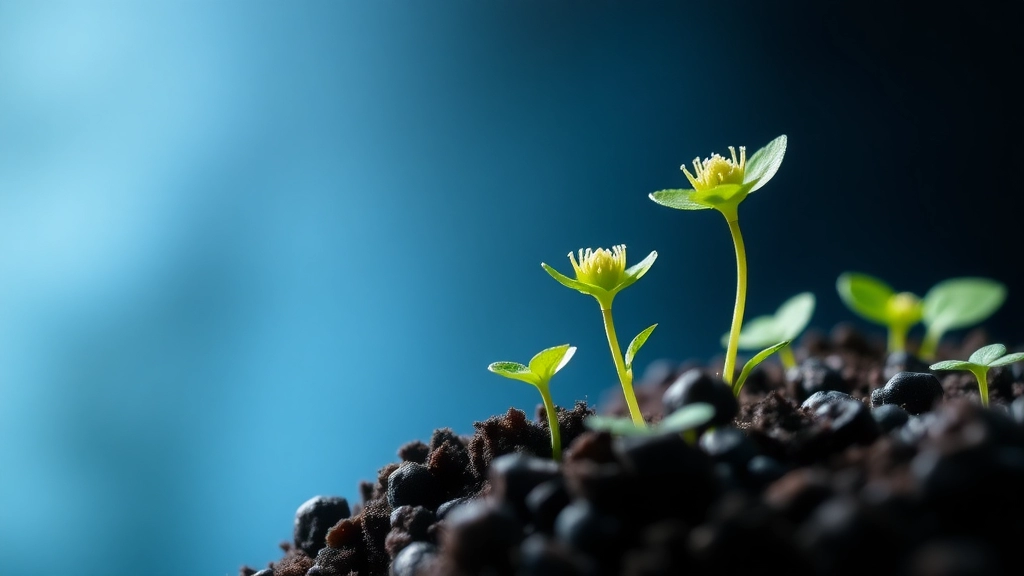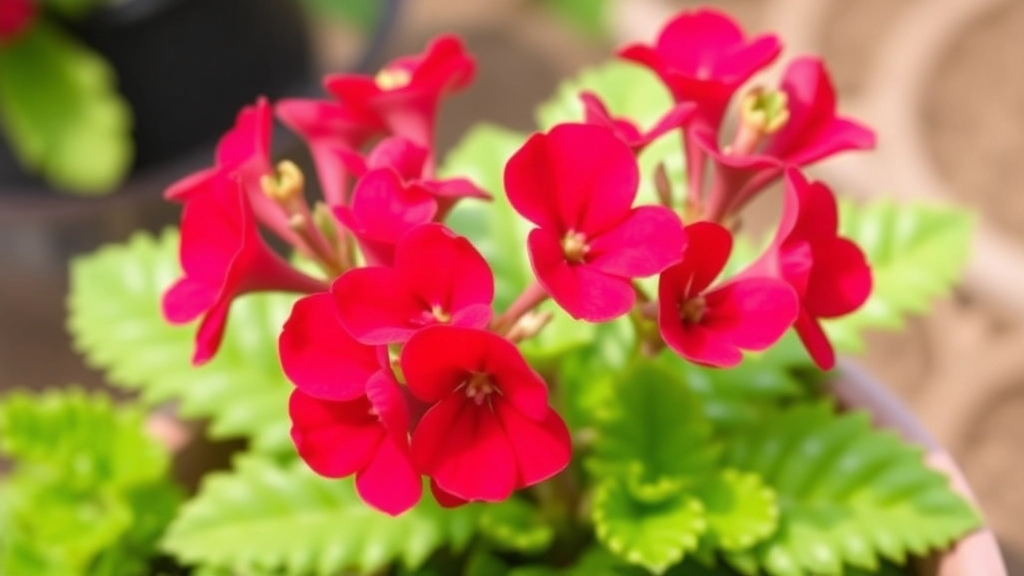Fixing a Leggy Kalanchoe
Are you frustrated with your leggy Kalanchoe? This common issue often stems from inadequate sunlight, improper watering, or poor pruning habits. Luckily, there are simple steps you can take to fix a leggy Kalanchoe and restore its lush, compact appearance.
Pruning Techniques
First, let’s address pruning techniques. Trimming back those elongated stems not only encourages new growth but also helps the plant redirect its energy.
Improving Lighting Conditions
Next, consider improving the lighting conditions. Kalanchoes thrive in bright, indirect sunlight, so placing your plant near a well-lit window can make a world of difference.
Adjusting Watering Practices
Finally, adjusting your watering practices and ensuring proper drainage will prevent future legginess and keep your Kalanchoe healthy.
Causes of Legginess in Kalanchoe
Have you ever noticed your Kalanchoe stretching awkwardly towards the light? This leggy growth can be frustrating for any plant enthusiast. Understanding the causes of legginess is the first step towards remedying the situation.
Legginess in Kalanchoe typically arises from a few key factors:
- Insufficient Light: Kalanchoe thrives in bright, indirect sunlight. When it doesn’t receive enough light, it stretches towards the nearest light source, resulting in elongated stems. For more tips, check out our comprehensive Kalanchoe plant care guide.
- Overwatering: Excessive moisture can weaken the plant, leading it to grow taller in search of stability and light.
- Lack of Pruning: If you neglect to prune your Kalanchoe, it may grow too tall and sparse, resulting in a leggy appearance. Learn more about propagating Kalanchoe leaves to manage growth effectively.
- Nutrient Deficiency: A lack of essential nutrients can stunt growth, causing the plant to stretch as it seeks out the necessary resources.
- Temperature Fluctuations: Sudden changes in temperature can stress the plant, prompting it to grow in a way that may appear leggy.
Recognising these causes can help you take the necessary steps to encourage a more compact and healthy growth pattern.
Pruning Techniques to Address Leggy Growth

So, you’ve noticed your Kalanchoe stretching and looking a bit too leggy, right?
Pruning is one of the best ways to tackle this issue and help your plant bounce back.
1. Timing is Key
- Best Time to Prune: Early spring is ideal. This is when your plant is gearing up for new growth.
2. Gather Your Tools
- Sharp Scissors or Shears: Ensure they’re clean to prevent any disease.
- Gloves: Optional, but they can protect your hands from sap.
3. Identify Leggy Stems
- Look for stems that are excessively long and lack leaves.
- Focus on those that are growing towards the light source, as they tend to stretch more.
4. Make the Cuts
- Cut Just Above a Leaf Node: This encourages new growth from that point.
- Aim to remove about a third of the leggy stem to promote bushiness.
5. Remove Dead or Damaged Leaves
- Snip off any leaves that are yellowing or wilting. This helps the plant focus its energy on healthy growth.
6. Clean Up
- Dispose of the cuttings properly to prevent pests or diseases.
7. Aftercare
- Water your Kalanchoe lightly after pruning, but don’t overdo it. This helps it recover without drowning.
How to Improve Lighting for Kalanchoe
One of the primary reasons for leggy growth in Kalanchoe is inadequate lighting. If your plant is stretching towards the light, it’s a clear sign that it needs more exposure.
Understanding Kalanchoe’s Lighting Needs:
Kalanchoe thrives in bright, indirect sunlight. Here’s how to ensure your plant receives the right amount of light:
- Location Matters: Place your Kalanchoe near a south or west-facing window. This ensures it gets ample sunlight throughout the day.
- Avoid Direct Sunlight: While Kalanchoe enjoys bright light, direct sunlight can scorch its leaves. A sheer curtain can filter the light if needed.
- Supplement with Grow Lights: If natural light is insufficient, especially during winter months, consider using grow lights. LED or fluorescent lights can provide the necessary spectrum for healthy growth.
- Monitor Light Levels: Keep an eye on your plant. If you notice it leaning or stretching, it’s a sign to adjust its position.
Signs of Insufficient Light:
- Leaves turning yellow
- Stems elongating
- Sparse foliage
By ensuring your Kalanchoe receives the right lighting, you can significantly reduce leggy growth and promote a fuller, more compact plant. For more detailed care tips, check out our pruning and care tips for leggy Kalanchoe. Additionally, if you’re wondering about specific varieties, our guide on light blue Kalanchoe varieties might be helpful.
Adjusting Watering Practices to Prevent Legginess

Have you ever noticed your Kalanchoe stretching towards the light, becoming leggy and unbalanced?
Watering practices play a crucial role in maintaining the compact growth of your plant.
Understanding Watering Needs
Kalanchoe thrives in well-draining soil and requires a careful balance when it comes to watering.
- Check Soil Moisture: Always check the top inch of the soil. If it feels dry, it’s time to water.
- Water Thoroughly: Ensure that water seeps through the drainage holes. This encourages healthy root growth.
- Avoid Overwatering: Too much water can lead to root rot, which weakens the plant and contributes to legginess.
- Water Frequency: Adjust your watering frequency based on the season. During warmer months, you may need to water more often, while in winter, reduce the frequency.
Signs of Improper Watering
Be on the lookout for signs that indicate your watering practices may need adjustment:
- Yellowing Leaves: This can signal overwatering.
- Shrivelling Leaves: A sign of underwatering, leading to leggy growth as the plant stretches for moisture.
Real-Life Example
I once had a Kalanchoe that seemed to grow taller and taller, losing its compact form. After adjusting my watering habits and ensuring I wasn’t overwatering, I noticed a significant improvement in its shape and health.
By fine-tuning your watering practices, you can help your Kalanchoe maintain a sturdy, compact growth.
Repotting Tips for Overgrown Kalanchoe
If you’ve noticed your Kalanchoe becoming leggy, repotting can be a crucial step in rejuvenating its growth.
Why Repotting Matters
Repotting not only provides fresh soil but also gives the plant more space to grow. An overgrown Kalanchoe can become root-bound, which leads to stunted growth and increased legginess.
The Role of Fertilization in Compact Growth

So, you’ve tackled the pruning and adjusted your lighting, but what about fertilization?
Many folks overlook this crucial aspect, thinking plants can thrive without a little extra love.
But let me tell you, the right fertilization can make a world of difference in keeping your Kalanchoe nice and compact.
Why Fertilization Matters:
- Nutrients Boost: Just like us, plants need a balanced diet. Fertilizers provide essential nutrients, ensuring your Kalanchoe grows strong and healthy.
- Prevents Stretching: A well-fed plant is less likely to stretch out in search of nutrients. This means you’ll have a bushier, more compact Kalanchoe.
- Flower Power: If you want those vibrant blooms, a good fertilization routine will help your plant produce more flowers rather than just focusing on leggy growth.
Fertilization Tips:
- Choose the Right Fertilizer: Look for a balanced, water-soluble fertilizer, ideally one formulated for succulents.
- Frequency: Feed your Kalanchoe every 4-6 weeks during the growing season (spring and summer).
- Dilution is Key: Always dilute your fertilizer to half-strength. Too much can burn those lovely leaves.
- Watch for Signs: If your plant looks yellow or droopy, it might be time for a nutrient boost.
By giving your Kalanchoe the right nutrients, you’re setting it up for compact growth and vibrant blooms.
How to Propagate Cuttings from Leggy Stems
If you’ve noticed your Kalanchoe becoming leggy, you might be wondering how to make the most of those elongated stems. Propagating cuttings from leggy growth is an effective way to rejuvenate your plant while ensuring you have new, healthy specimens.
Why Propagate?
Leggy stems can indicate that your plant is stretching for light. By taking cuttings, you not only address the aesthetic issue but also give your Kalanchoe a chance to thrive in a more compact form.
Steps for Propagating Cuttings:
- Select Healthy Stems:
- Look for leggy stems that are healthy and free from pests or diseases.
- Aim for stems that are at least a few inches long.
- Make Clean Cuts:
- Use a sharp, sterilised knife or scissors to cut the stem just below a leaf node.
- This ensures a clean cut, reducing the risk of infection.
- Prepare the Cuttings:
- Remove the lower leaves from the cut stem, leaving a couple of leaves at the top.
- This helps to focus the plant’s energy on root development.
- Allow to Callous:
- Place the cuttings in a dry, warm area for a few hours to allow the cut end to callous over.
- This step is crucial as it prevents rot when the cutting is placed in soil.
- Plant the Cuttings:
- Use a well-draining potting mix, ideally one formulated for succulents.
- Insert the cut end into the soil, burying it about an inch deep.
- Water Sparingly:
- After planting, lightly water the soil to settle it around the cutting.
- Avoid overwatering, as this can lead to rot.
- Provide Adequate Light:
- Place the pot in a bright, indirect light location.
- This will encourage healthy growth without the risk of scorching the new cuttings.
- Monitor Growth:
- Keep an eye on your cuttings for signs of new growth, which typically indicates successful rooting.
- This can take a few weeks, so be patient!
By following these simple steps, you can effectively propagate your leggy Kalanchoe and enjoy new plants that are more compact and robust. For more detailed guidance, check out our step-by-step guide on growing Kalanchoe from cuttings. Additionally, ensure your propagated plants thrive by following these essential Kalanchoe care tips for summer success.
Ever noticed how your Kalanchoe seems to stretch toward the light? It’s a common concern for plant lovers. If your Kalanchoe is leaning or becoming leggy, the way you position and rotate it can make a world of difference.
### Why Rotate Your Kalanchoe?
Plants naturally grow toward their light source. If you keep your Kalanchoe in the same spot, one side might get all the sun, leading to uneven growth. Here’s how to keep it balanced:
– **Rotate Regularly**: Turn your plant every couple of weeks. This encourages even growth all around.
– **Watch for Direction**: If you notice one side is getting taller, it’s time for a rotation.
### Finding the Right Spot
Placement is key. Here are some tips to ensure your Kalanchoe gets the light it craves:
– **Near a Window**: A south-facing window is usually ideal.
– **Avoid Obstructions**: Ensure no furniture or other plants block the light.
– **Distance Matters**: Keep it a few feet away from the window to prevent leaf scorch.
### Signs You Need to Adjust Positioning
If you spot these signs, it’s time to rethink where your Kalanchoe lives:
– **Leggy Growth**: If it’s stretching more than usual, it’s a sign it’s not getting enough light.
– **Yellowing Leaves**: This could indicate it’s getting too much direct sunlight.
By rotating and positioning your Kalanchoe wisely, you’ll help it thrive and maintain a compact shape. For more detailed care tips, check out the [complete guide to Kalanchoe plant care](https://planthq.org/complete-guide-to-kalanchoe-plant-care/) and learn how to [make your Kalanchoe flower again](https://planthq.org/how-to-make-your-kalanchoe-flower-again/).
FAQs on How to Fix a Leggy Kalanchoe
What is a leggy Kalanchoe?
A leggy Kalanchoe is a plant that has long, stretched-out stems with few leaves. This often happens when the plant is not receiving enough light or proper care.
When is the best time to prune a leggy Kalanchoe?
Early spring is the ideal time to prune your Kalanchoe. This is when the plant is preparing for new growth.
What tools do I need for pruning my Kalanchoe?
You will need sharp scissors or shears and optionally, gloves to protect your hands from sap.
How do I identify leggy stems on my Kalanchoe?
Look for stems that are excessively long and lack leaves, especially those growing towards the light source.
How should I make the cuts when pruning?
Cut just above a leaf node to encourage new growth from that point. Aim to remove about a third of the leggy stem to promote bushiness.
What should I do with dead or damaged leaves?
Snip off any leaves that are yellowing or wilting to help the plant focus its energy on healthy growth.
How should I dispose of the cuttings?
Dispose of the cuttings properly to prevent pests or diseases from affecting your plant.
What aftercare is needed post-pruning?
Water your Kalanchoe lightly after pruning, but don’t overdo it to help it recover without drowning.
How should I adjust my watering practices to prevent legginess?
Check the top inch of the soil for dryness before watering. Ensure water seeps through the drainage holes and avoid overwatering to prevent root rot.
What are signs of improper watering?
Yellowing leaves can signal overwatering, while shriveling leaves indicate underwatering, leading to leggy growth as the plant stretches for moisture.
How does fertilization affect the growth of my Kalanchoe?
Fertilization provides essential nutrients, preventing the plant from stretching out in search of nutrients and promoting a bushier, more compact growth.
What type of fertilizer should I use for my Kalanchoe?
Use a balanced, water-soluble fertilizer, preferably one formulated for succulents.
How often should I fertilize my Kalanchoe?
Feed your Kalanchoe every 4-6 weeks during the growing season (spring and summer).
What should I watch out for when fertilizing?
Always dilute your fertilizer to half-strength to avoid burning the leaves. If the plant looks yellow or droopy, it might need a nutrient boost.
References
-
How to Fix a Leggy Kalanchoe Plant
-
Kalanchoe Plant Care Indoors
-
Kalanchoe: How to Grow and Care for Kalanchoe Plants
